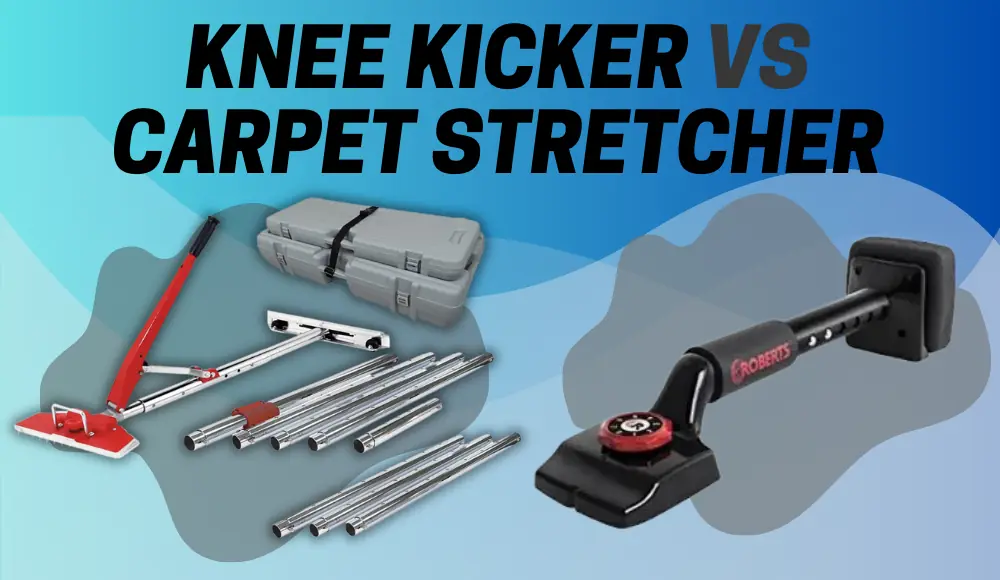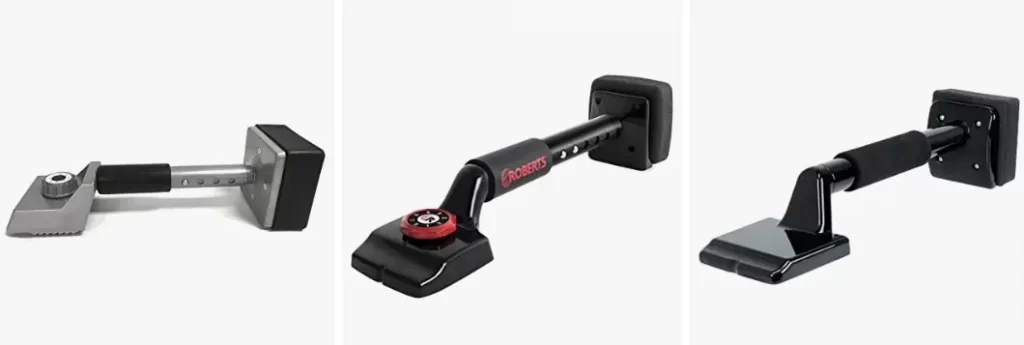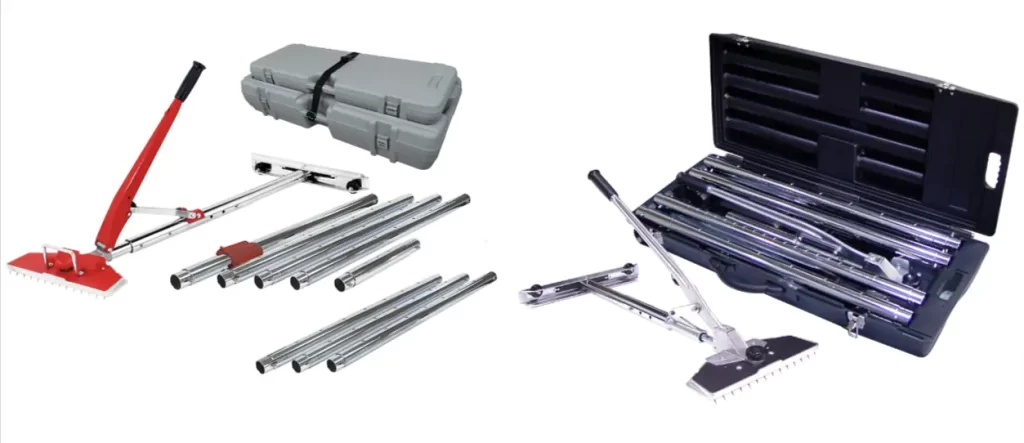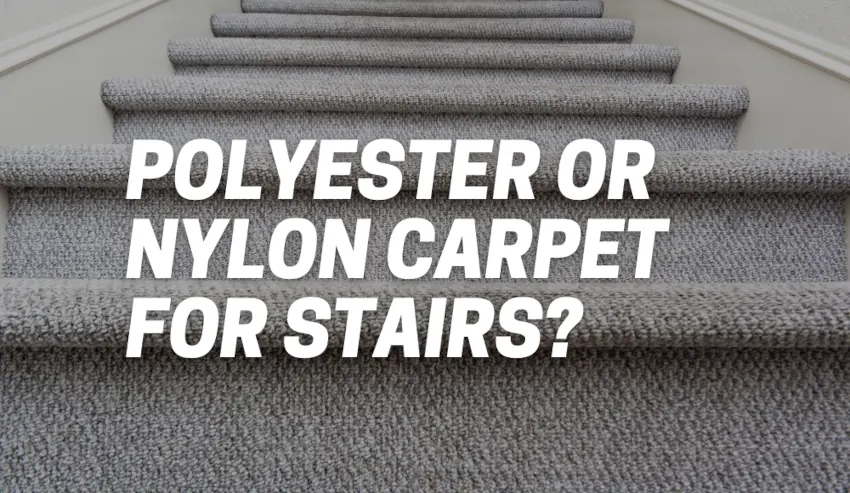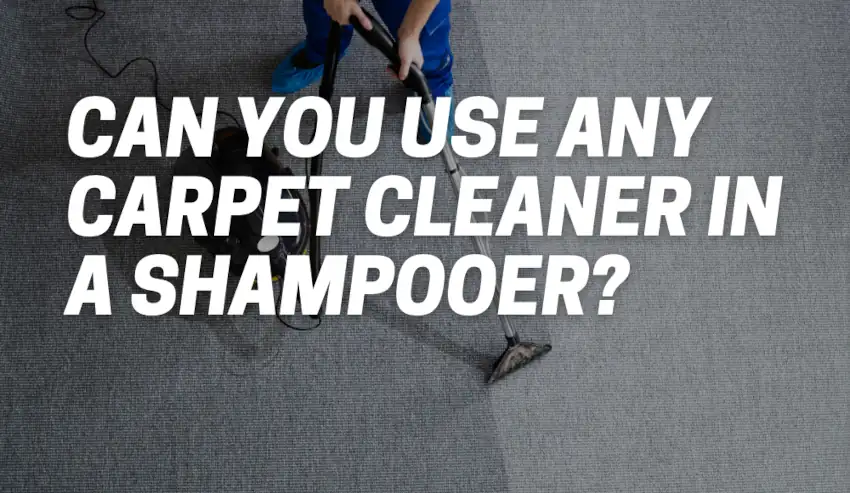Last updated on August 17th, 2023 at 05:57 am
Carpet installation is a process that requires attention to detail and careful planning. Whether you’re renovating your home or simply replacing your old carpets, it’s important to choose the right tools for the job. With the myriad of tools available in the market, it can be overwhelming to decide which one to use for your carpet installation. Knee kicker vs carpet stretcher vs power stretcher – which tool is best?
This is the main question for this article.
The Importance of Choosing the Right Tools for Carpet Installation
First things first. There is no need to compare three different tools but only two. And here is why.
All tools for stretching a carpet are called carpet stretchers. But for the purpose of differentiation, each specific type of carpet stretcher is named differently. This is why there is no need to compare “knee kicker vs carpet stretcher vs power stretcher” because a carpet stretcher and a power stretcher (carpet power stretcher) mostly refer to the same tool.
Before delving into the different types of tools used in carpet installation, let’s first take a brief overview of the carpet installation process.
- First, you’ll need to measure your room and calculate how much carpet you’ll need.
- Next, remove any old flooring and ensure that your subfloor is clean and level.
- You’ll then need to lay down tack strips around the perimeter of your room and install padding on top of it.
You can lay down your new carpet on top of the padding and use specific tools to stretch it out and secure it onto the tack strips.

Choosing the right tool for each step of this process is crucial in ensuring a successful installation.
Not only will using improper tools make for a more difficult process but may also lead to damage to both carpets and floors.
In this article, we will be discussing three popular carpet installation tools: knee kicker, carpet stretcher, and power stretcher – their uses along with their pros & cons so that you can make an informed decision on which tool would be best suited for your situation.
Knee Kicker
Kick Your Carpet Into Shape
If you’ve ever watched a carpet installer at work, you may have noticed them using a strange tool that looks like it was designed for torture. This tool is called a knee kicker, and it’s an essential tool for installing carpets.
The knee kicker is a small device that has two metal teeth on one end and a padded handle on the other.
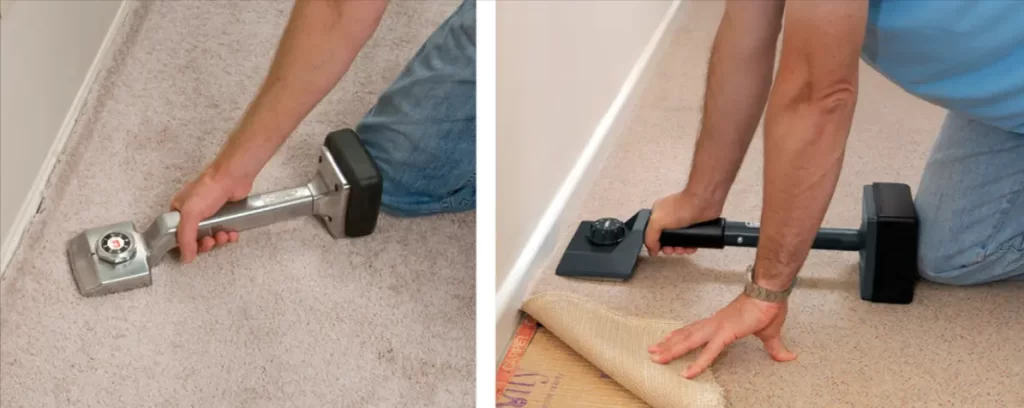
The teeth are placed on the carpet about six inches from the wall, and then the installer applies pressure to the padded handle with their knee. The force of this kick stretches the carpet towards the wall, allowing it to be secured in place.
The knee kicker is an excellent choice for small rooms or areas where power stretchers cannot reach. It’s easy to use and doesn’t require any electricity or complicated setup.
However, using a knee kicker can be hard on your knees, so it’s important to take frequent breaks and stretch your legs when using this tool for extended periods of time.
Keep reading and we will show all three tools in action so you can clearly understand the difference.
Additionally, since a knee kicker relies on manual force to stretch the carpet, it can be less effective than other tools in situations where carpets need significant stretching or when dealing with thicker carpets.
In general, if you’re working with smaller rooms or thin carpets that don’t require much stretching force, then a knee kicker is likely to be an effective tool. When deciding whether to use a knee kicker in carpet installation, consider factors such as room size and carpet thickness.
How to use a knee kicker
—
Knee kickers are often used in closets or hallways where power stretcher access is limited but can also be used in larger rooms for specific sections of installation needing tight corners stretched around posts or pillars for example.
Ultimately though if you want your carpets installed professionally without any chance of future wrinkles appearing then hiring professionals who have all three tools at their disposal would be best practice.
Carpet Stretcher aka Power Stretcher
Is a knee kicker the same as a carpet stretcher?
If you are new to the world of carpet stretching, you may have heard other tool names, such as carpet stretcher and power stretcher.
An obvious question may arise: Is a knee kicker and carpet stretcher the same thing?
No, knee kicker and carpet stretcher (or carpet power stretcher) are two different types of carpet stretching tools. A carpet stretcher is a tool used to stretch and smooth out the carpet during installation.
A power stretcher consists of a long telescoping pole, a base plate, and a stretching mechanism that utilizes a lever and a stretching head with gripping teeth that stretches the carpet tightly onto the tack strips.
The main function of a power stretcher is to stretch the carpet across the length and width of a room so that it fits snugly against the walls and corners.
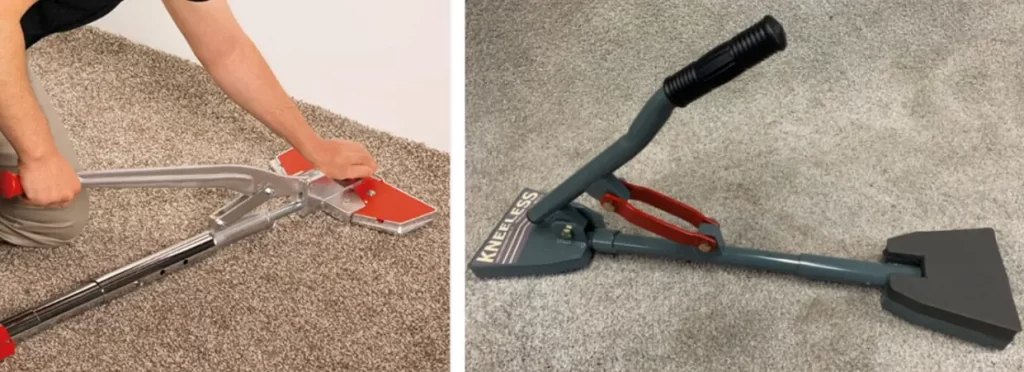
The stretcher is designed to help eliminate wrinkles, buckling, or bunching in the carpet caused by improper installation.
The process of using a stretcher involves laying out the carpet over the padding and securing one end to the tack strips around the perimeter of the room.
Then, using the stretcher, you pull on one side of the carpet while pressing down on the other side. The stretching process should be done section by section until all areas of the room are stretched tight and smooth.
Price difference
Another difference between a knee kicker and a carpet stretcher is the price.
The price difference can vary depending on the brand, quality, and specific features of the tools. Generally, knee kickers are less expensive compared to carpet stretchers.
A basic knee kicker can range in price from $30 to $80, while more advanced models with additional features may cost around $100 or more. The price variation is influenced by factors such as the quality of materials used, durability, and design.
On the other hand, carpet stretchers are more specialized and complex tools, typically costing more than knee kickers.
The price of a carpet stretcher can range from $100 to $500 or more, depending on the type (such as manual or power stretcher), brand, and features it offers.
It’s important to consider the specific needs of your carpet installation project and balance your budget with the desired quality and features of the tools.
Prices can vary between different suppliers and retailers, so it’s recommended to check with local stores or online marketplaces to get specific and up-to-date pricing information.
| Knee Kicker | Carpet Power Stretcher | |
|---|---|---|
| Purpose | Positioning and adjusting carpets | Stretching and tensioning carpets |
| Tool Size | Hand tool | Larger tool |
| Components | Padded cushion and telescoping handle | Long handle, base plate, stretching mechanism (lever, stretching head, gripping teeth) |
| Usage | Pushes carpet into place, creates tension, and stretches the carpet across the room | Stretches carpet tightly across the room, eliminating slack and ensuring a smooth installation |
| Function | Minor adjustments and positioning | Provides a tight, wrinkle-free installation |
| Commonly Used With | Used in conjunction with a power stretcher for larger installations | N/A (Can be used independently or with other carpet installation tools) |
| Price | Price range from $30 to $80 | Price from $100 to $500 or more |
Pros and cons of using a carpet stretcher
Using a carpet stretcher has several advantages over other tools like knee kickers or power stretchers.
For starters, it can create an extremely tight fit, making it ideal for heavy-traffic areas like hallways or entryways where carpets tend to wear out faster.
Additionally, stretching carpets properly will prevent tripping hazards from any wrinkles or bumps in high-traffic areas.
However, stretching carpets with this tool can also be time-consuming and require some physical effort since you have to apply constant pressure while stretching each portion of your work area. It also requires some experience so as not to damage carpets during installation.
| Pros | Cons |
|---|---|
| Creates an extremely tight fit | Time-consuming installation process |
| Ideal for heavy-traffic areas | Requires physical effort |
| Prevents tripping hazards from wrinkles or bumps | Requires experience to avoid damaging carpets |
| Ensures a professional and smooth installation |
When to use a Carpet Stretcher in Carpet Installation
A Carpet stretcher should be used when installing wall-to-wall broadloom carpets or when replacing an existing fitted rug.
Because this tool provides more accuracy than other tools such as knee kickers which simply push wrinkles aside rather than remove them from underneath while carpet stretchers are better suited for large commercial spaces where people walk on the carpet in different directions and traffic patterns vary.
Use a carpet stretcher if you want to ensure that your newly installed carpet lasts longer and looks better.
Comparison between Carpet Stretcher vs Knee Kicker
Carpet installation can be a challenging task, requiring the right tools to achieve a professional finish.
—
Each tool has its own unique features that make it effective for specific tasks. In this section, we’ll compare the knee kicker and power stretcher to determine which tool is best for different types of carpets.
Differences in Effectiveness
The knee kicker is effective in small areas or tight corners where a power stretcher cannot fit. However, it is not as effective as the power stretcher in stretching larger areas of carpet and ensuring it stays tight and smooth.
The carpet stretcher uses a lever and teeth system to stretch the carpet evenly across the entire room while minimizing buckling or bubbles that may form during installation.
Which Tool is Best for Different Types of Carpets?
The type of carpet being installed also plays an important role in deciding which tool should be used.
For instance, Berber carpets tend to be difficult to stretch evenly without causing damage due to their looped construction; therefore, it’s best to use a power stretcher when installing them.
On the other hand, low-pile carpets are easier to handle with a knee kicker. It’s important to consult with a professional installer or flooring expert to determine which tool is best for the installation of specific types of carpets.
FAQ
Should carpet be power stretched?
Yes, if you are installing a wall-to-wall carpet power stretching is highly recommended. It ensures that the carpet is properly stretched and secured to the floor, resulting in a smooth and wrinkle-free appearance.
Without power stretching, the carpet may develop wrinkles, ripples, and unevenness over time, compromising its durability and aesthetics. Think of it as giving your carpet a firm and snug hug, ensuring it stays in place and maintains its beautiful look for years to come.
So, don’t skip the power stretching step – it’s like giving your carpet the VIP treatment it deserves.
When thinking about the right tool – knee kicker or power stretcher – here what is recommended to consider:
| Main Points | Description |
|---|---|
| Both tools used | In a normal room-sized installation, both a kicker and a stretcher are used. The kicker is used for the first edge, while the stretcher is used for the rest of the carpet. Kickers are also used in corners and on stairs where the stretcher is not practical. |
| Kicker’s purpose | The kicker is ideally used to attach the carpet to the tack strip. |
| Stretcher’s purpose | A stretcher is used to attach the unanchored sides of the carpet. It is anchored on one side and stretched to the opposite side. |
| Preference for stretcher | Professionals prefer using a stretcher as much as possible because a carpet that has only been kicked may not hold up well over time. |
| Using only a kicker | Can you stretch carpet with a knee kicker? Using only a kicker can still achieve a satisfactory job, but it requires more effort and physical exertion. A 90% job can be done in a small space with a kicker, but it may be more physically demanding. |
| Limitations of kicker | For larger jobs, the smaller head of the kicker can lead to carpet ripping if you try to achieve the same amount of stretch as a power stretcher, which offers more effective stretching without requiring as much effort. |
